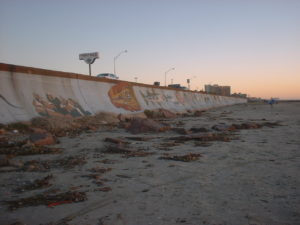
The Galveston Seawall has some murals painted on it (Creative Commons license attribution: photo courtesy Ted Gresham)
If you’ve been to Galveston, you’ve likely driven on or walked along the seawall. It’s hard to imagine Galveston without the seawall today.
The seawall came about as a result of the 1900 Galveston hurricane, in which thousands of people were killed. City leaders at the time thought having a seawall would protect the city and its people from future hurricanes.
The seawall has certainly helped. According to a USA Today article, the US Army Corps of Engineers said that approximately $100 million in damage was avoided, thanks to the seawall, when Hurricane Alicia hit the island in August 1983.
Some things you might not know about the seawall include:
1. The seawall today is 10 miles long.
Construction on the seawall began in 1902, in the original length of the seawall was 3.3 miles. Over time, however, the length of the seawall grew to over 10 miles long. The seawall stands 17 feet high.
2. The seawall has a concave design.
The seawall, as shown in the picture accompanying this article, has a concave design. The purpose of this design was to keep ways from crashing forward, towards the city, but rather to crash upwards and fall back away from the city.
According to a Wall Street Journal article, Hurricane Ike, which hit the island in September 2008, brought a storm surge in large waves that overtopped the seawall. Discussions have taken place about how the seawall can be strengthened even more.
3. A consulting engineer on the seawall was the author of Robert’s Rules of Order.
Henry Martyn Robert (1837-1923) is perhaps best known for authoring Robert’s Rules of Order, a parliamentary procedure guidebook. But he is remembered in Galveston as being one of the consulting engineers on the seawall project.
Robert was born in South Carolina. He was graduated from the U.S. Military Academy at West Point, New York, and worked on major river and harbor improvement projects for the U.S. government.
4. The seawall is listed in the National Register of Historic Places.
The seawall received its listing in 1977. In 2001, the seawall was designated a National Civil Engineering Landmark by the American Society of Civil Engineers.
